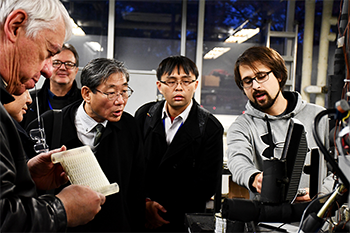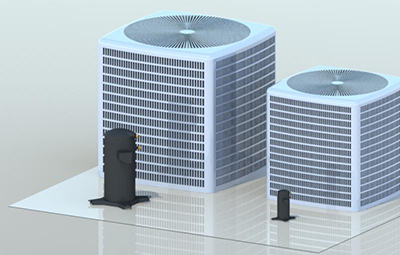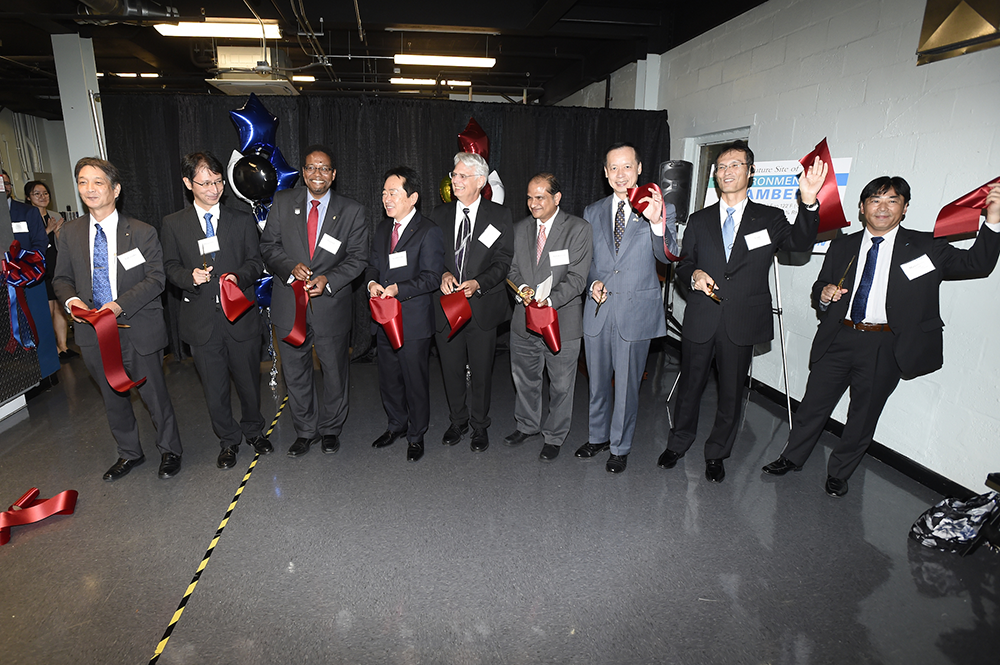Heat pumps are a great option for decarbonizing building heating, but they struggle to perform in colder climates, curtailing widespread adoption. Furthermore, while electric heat pumps are a strong candidate for replacing fossil fuel-driven heating systems, current heat pumps typically use refrigerants that have a high Global Warming Potential, and so still emit greenhouse gases.
Objective
Our goal is to develop a 10-ton rooftop saturation heat pump prototype and demonstrate its viability for cold climate applications. We are engineering a multi-stage, two-phase refrigerant injection system that enables efficient compression over large temperature lifts, allowing the system to heat buildings to comfortable temperatures, even in cold climates. The prototype will use an ultra-low GWP refrigerant (propane) and will incorporate safety measures allowing for the use of this flammable refrigerant.
Thermoelastic cooling, or elastocaloric cooling, is a cutting-edge solid-state based alternative cooling technology to the state-of-the-art vapor compression cooling systems that dominate the world today. Being environment friendly without any global warming potential, these thermoelastic cooling systems could reduce energy expenses and carbon emission since they are potentially more efficient than the vapor compression cycle (VCC). Nevertheless, because of its immature nature, its realistic application potential requires comprehensive research in material fundamentals, cycle design, system simulation, the proof-of-concept prototype development and testing [1].
Objective
The primary objective of this project is to develop a NiTix cascade system that can yield 50-100 K temperature gradient and 50 W of cooling capacity (separately).
In our past research experiences with electrochemical (EC) membrane technology, we have demonstrated an ability to compress a variety of working fluids as well as to separate fluid mixtures, even at dilute concentrations. In our ammonia compression experiments, we saw that, while sustained compression is possible even at high pressure ratios, back diffusion of ammonia is problematic. We also saw back diffusion impede the performance of an EC dehumidifier. Clearly, the multitude of mass transfer processes occurring in the cells is significant and we must understand them to design improved pumping devices. We examine the performance of the ammonia EC compressor and the EC dehumidifier to characterize these processes. We also look at ways to mitigate adverse mass transfer phenomena via mass transfer enhancement caused by the electric wind phenomenon.
Objective
The objective of this project is to develop efficient not-in-kind energy conversion devices with potential applications in air conditioning and energy storage, among others. Through this work we will better understand the fluid transfer processes occurring in EC cells. We will also look at methods to increase the mass transfer rates. Through these varied research efforts, we will produce practical results, which engineers can use to develop improved EC pumping devices.
High-temperature heat pumps offer an eco-friendly alternative to the traditional oil, gas and coal boilers commonly used for industrial processes. A high-temperature heat pump absorbs industrial waste heat and upgrades it to a higher temperature. As of 2022, industrial processes generate 30% of U.S. greenhouse gas carbon emissions, according to the U.S. Environmental Protection Agency. Reducing emissions caused by industrial processes is essential to achieve net zero emissions by 2050; high-temperature heat pumps can play an important role.
Objective
The University of Maryland and its partners will advance the state of the art of high-temperature heat pumps to enable continuous, zero-carbon heat for processes above 200° C. To improve current heat pump technology, the team will adopt a novel multi-stage, two-phase injection system, coupled with a highly efficient heat exchanger system to deliver the heat. The proposed approach of near-saturation cycle processes, with the help of multi-stage compression, aims to achieve 71% of Carnot efficiency at 200° C with a temperature lift of 100 K.
In 2019, the global power generation for renewables rose by 1.1% to 27% according to the yearly report by enerdata. This rising trend since the 2000’s is thanks to the growth of new wind and solar technologies. As the demand for wind and solar increases, the demand for more capacity is required, therefore, the need for storage technologies are needed such as hydro and air compression. In particular, compressed air energy storage or CAES has become more and more of a viable option thanks to research done on isothermal compression. Methods developed for such purposes could also be applied for refrigeration. The benefits in efficiency improvements for refrigeration systems would be large, especially since compressors contribute to a large part of the input work. It is reported that compressors driven by electric motors consume 227 billion every year so there are huge energy savings to be earned. This is also a step forward in achieving carnot efficiency, which is the highest possible efficiency for a given system.
Objective
The objective of this project is to build and test a working prototype that will successfully run a refrigeration cycle with the compressor running isothermally. This includes conceptual design, thermodynamic analysis, performance modeling, small scale prototype testing and lastly, prototype scale up.
Wood drying is an essential step in preparing lumber to be used for building construction, furniture and more. Currently, wood drying is a carbon-intense process that relies largely on the combustion of various carbon-emitting fuels. Heat pumps offer a promising opportunity to help decarbonize the lumber industry.
Objective
A CEEE-led research team is innovating a two-chamber wood-drying heat pump that would nearly double the heat pump’s drying efficiency – helping to make the technology an attractive option for the lumber industry. Heat from the first chamber would be recovered and used to warm the second chamber, nearly doubling the amount of wood dried for the same electrical energy input. The eventual prototype will use refrigerants with low Global Warming Potential, furthering the heat pump’s sustainability.
In most countries, building energy demands such as heating and cooling occupy major portions of overall energy consumptions. To decrease the usage of refrigerants and gases that significantly contribute to the global warming, latent heat energy storage technologies with PCM coupled with building applications can be utilized. New high performance PCM-HX for building applications can be developed using a novel framework for performance evaluation and design optimization.
Objective
The two main objectives are to develop and test a PCM embedded heat exchanger capable of load shifting heating, ventilation, and air-conditioning (HVAC) equipment, and to release an online PCM-HX performance simulation tool to assist the design community on commonly used user cases such as single/multiple flow path(s) fluid-to-PCM configuration and air-to-fluid-to-PCM configuration.
Air-to-Refrigerant heat exchanger performance has largely remained static for decades using tube-fin designs. Shape-optimized non-round tube heat exchangers provide enhanced performance using less material and refrigerant charge. State-of-the art metal additive manufacturing has the ability to produce one continuous product with micron level resolution and is being utilized to create next generation heat exchanger prototypes for experimentation.
Objective
The main objective is to design high performance air-to-refrigerant heat exchangers that are 25% lighter, 25% more compact with a heat exchanger charge reduction of 30% compared to AC systems available on the market today. The reduced charge advantage will facilitate the use of A2L and A3 refrigerants for certain applications.
RoCo is a Roving Personal Comfort device, which provides ultimate personal thermal management for people in inadequately or un-conditioned environments. It provides 12% to 30% energy savings compared with typical conditioned buildings systems, and better thermal and mobile comfort to occupants.
RoCo’s intelligent nozzle smartly delivers conditioned air to parts of the body needing it most. As various parts of the body have different sensitivity levels for thermal sensation, RoCo ensures you benefit from cooling through flexible smart nozzles that adjust air supply locations and conditions.
The heart of this personal cooling/heating device is the next generation miniature heat pump system with built-in PCM storage. Benefiting from a linear mini-compressor and next generation air-to-refrigerant heat exchangers, the system delivers cooling and heating at minimum power consumption without releasing waste heat.
It is up to 30 percent more efficient than conventional residential or commercial heat pump systems. This significantly cuts utility bills.
Researchers estimate that we spend 90% of our lives within buildings. Therefore, the indoor environment is essential. Heating, ventilating and air-conditioning (HVAC) is one of the main applications to control the indoor environment. Variable refrigerant flow (VRF) system, which was introduced in the U.S. at around 2002, has been installed in various types of commercial buildings, including offices, hotels, luxury apartments, low-income multi-family buildings, and universities.
The term variable refrigerant flow (VRF) first came into existence in 1982 by Daikin Industries, Ltd., which was also known as variable refrigerant volume (VRV) [1]. Since the 1980s, VRF systems have been widely used in Japan: 50 % of midsize office buildings (up to 70,000 ft2 or 6,500 m2) and 33% of large commercial buildings (more than 70,000 ft2 or 6,500 m2) [2]. VRF systems have been introduced to the U.S. at around 2002 and are widely used in commercial and office buildings [3]. VRF system is sometimes referred as multi-IU system, multi-unit air conditioning (MUAC) system or Multi Evaporator Air Conditioning (MEAC) system [4]. The mass flow rate of each IU is controlled by the electronic expansion valve (EEV). This simple-structure VRF system is also called Heat Pump VRF (HPVRF) system [3]. HPVRF system can only provide heat or cooling at one time. By adding so-called heat recovery unit, Heat Recovery VRF (HRVRF) system which is able to heat and cool simultaneously can be designed[5,6].
Energy-saving potentials of the VRF system were found to promise 27.1-57.9% when compared to the variable air volume (VAV) system. When compared with traditional air conditioning or heat pump system, VRF systems are well known for its installation flexibility and systematic modularity. VRF systems usually consists of multiple direction expansion indoor units (IUs), a variable speed compressor, several electronic expansion valves (EEVs) and flow rate distribution units. The system could provide a precis control of the refrigerant flow rate via the cooperation of variable speed compressor and EEVs. Meanwhile, the system also allows individual control of each IU. One trend in both industry and academia is to introduce more functions in VRF system to make it a comprehensive building air conditioning solution in both residential and commercial buildings. As for this project (Figure 1), more and more functions have been added since the first-generation system. Current system is MFVRF system, and we are pursuing novel VRF concept.
Objectives
The main objective of this project is to develop a new VRF system considering thermal comfort and indoor air quality.
- VRF system design;
- Energy and economic analysis of VRF system
- Accurate steady and dynamic modeling of VRF system
- Field test for VRF system under different humidity and different ambient temperature
- Field test for VRF system under cooling mode & heating mode
- Sensitivity analysis of VRF system
- Data mining from the field test data
Understanding heat transfer and pressure drop in heat exchangers is crucial to improving performance. Adding internal grooves to tubes and utilizing new materials are current avenues used to increase heat transfer capabilities. Due to the complexities in flow profiles, predicting heat transfer characteristics proves difficult. By providing a dedicated facility, novel tube designs can be tested and valuable insights on heat transfer and pressure drop can lead to further designs. Experimental results can lead to correlation development and validation, leading to reduced costs during research and development, as well as paving the way for better enhancements.
Objective
The primary objective is to design and build a single test facility that can support various fluid pairs, operating conditions, orientations and outer tube geometries. Each tube will be evaluated at various conditions as both evaporator and condenser, and thermal and hydraulic performance will be evaluated. Integration between experimentally verified correlations and CoilDesigner will allow for future performance to be predicted.


 The research initiatives in the Daikin Lab are effectively making great strides to maximize energy efficiency and to reduce carbon emissions in the world. CEEE is a leader in research related to air-conditioning, refrigeration and heat pumping with a specific focus on the modeling and optimization tools for energy conversion systems and developing comprehensive information for the detailed physics of transport processes, innovative energy conversion components and systems, and new cost-effective test methods.
The research initiatives in the Daikin Lab are effectively making great strides to maximize energy efficiency and to reduce carbon emissions in the world. CEEE is a leader in research related to air-conditioning, refrigeration and heat pumping with a specific focus on the modeling and optimization tools for energy conversion systems and developing comprehensive information for the detailed physics of transport processes, innovative energy conversion components and systems, and new cost-effective test methods.  "Climate change won't stop unless we stop it. Society needs technologies that serve everyday needs - like keeping water warm and perishable food cool - that don't adversely affect our climate. The A. James Clark School of Engineering is proud to host the Daikin Energy Innovation Laboratory within CEEE.
"Climate change won't stop unless we stop it. Society needs technologies that serve everyday needs - like keeping water warm and perishable food cool - that don't adversely affect our climate. The A. James Clark School of Engineering is proud to host the Daikin Energy Innovation Laboratory within CEEE.  air-conditioners in the world by 2050. The Daikin Lab will help propel an entire industry to manufacture 5.6 billion air conditioners that are more efficient at half the volume and a third of the weight to operate in buildings with no net energy consumption.
air-conditioners in the world by 2050. The Daikin Lab will help propel an entire industry to manufacture 5.6 billion air conditioners that are more efficient at half the volume and a third of the weight to operate in buildings with no net energy consumption.  The
The